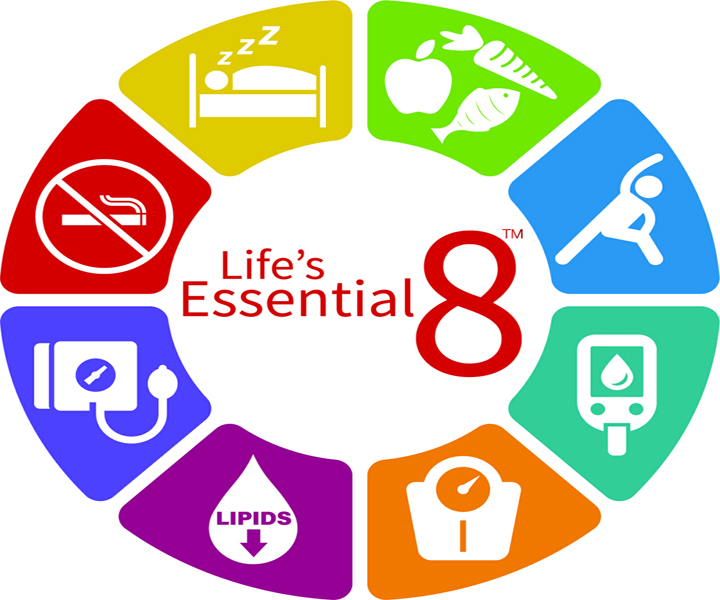Association of Sleep with Cardiovascular Health
Journal of the American
Heart Association (AHA): Published on November, 2022
Sleep, alongside diet and physical activity (PA), is one of
the 3 pillars of health, but unlike other health behaviors, healthy sleep is
not included in the American College of Cardiology/American Heart Association
(AHA) cardiovascular disease (CVD) prevention guidelines.
Sleep disorders and unhealthy sleep behaviors have been
extensively linked to elevated cardio-metabolic risk and CVD, with effect
sizes similar to those observed for other health behaviors such as diet and
physical activity.
A 2016 AHA statement on sleep concluded that short and
poor‐quality sleep and sleep disorders are associated with higher obesity,
hypertension, and diabetes risk. Irregularity in sleep timing and duration
has also been linked to metabolic abnormalities and higher CVD risk.
Further, poor sleep is related to poor diet quality and lower
PA and may influence CVD risk by interacting with these lifestyle factors.
The role of sleep in achieving
ideal cardiovascular health (CVH) has not been well characterized.
The American Heart
Association’s Life’s Simple 7 (LS7) does not include sleep. The seven items
that are included are cigarette smoking, diabetes, hypertension, high
cholesterol level, obesity, physical inactivity, and poor diet.
TAKE-HOME MESSAGE
This study is trying to make the
case for adding sleep to the LS7. The authors used data from the MESA
(Multi-Ethnic Study of Atherosclerosis) Sleep Study involving 1920 participants,
which included overnight polysomnography, 7-day wrist actigraphy, and validated
questionnaires.
Incorporation of sleep metrics into
AHA's LS7 scoring predicted cardiovascular disease (CVD) risk; participants in
the highest tertile of sleep duration had a 43% lower incidence of CVD than
those in the lower tertile.
The Life's Simple 7 score and all
iterations of an “Essential Eight” score, that additionally incorporate sleep
health measures, were related to cardiovascular disease prevalence.
These findings highlight the
importance of simple sleep characteristics on overall cardiovascular health,
with implications for primary prevention efforts.
The approach to promoting a healthy
lifestyle, which traditionally focused heavily on diet and physical activity,
should be expanded to encompass behaviors across the 24‐hour period, including
sleep.
Health care providers should assess
their patients' sleep patterns, discuss sleep‐related problems, and educate
patients about the importance of prioritizing sleep to promote CVH.
American
Heart Association adds sleep to the cardiovascular health checklist.
American Heart Association’s checklist to measure cardiovascular health is updated, now called Life’s Essential 8, adding healthy sleep as essential for optimal cardiovascular health.
Doctors Liked to Read More

American Heart Association’s
checklist to measure cardiovascular health is updated, now called Life’s
Essential 8, adding healthy sleep as essential for optimal cardiovascular
health.
Other health and lifestyle factors
in the checklist, which were part of the previous, 7-item scoring tool, are
nicotine exposure, physical activity, diet, weight, blood glucose, cholesterol
and blood pressure.
The new sleep metric suggests 7-9
hours of sleep daily for optimal cardiovascular health for adults, and more for
children depending on age.
The updated scoring can now be used
for people ages 2 and older, and four components are measured in new ways: a
new guide to assess diet; nicotine exposure replaces cigarette smoking to
include electronic cigarettes (vaping) and exposure to secondhand smoke;
non-HDL cholesterol is suggested instead of total cholesterol; and the blood
sugar measure is expanded to include hemoglobin A1c levels.
BACKGROUND
Although sufficient and healthy
sleep is inversely associated with cardiovascular disease (CVD) and its risk
factors, the American Heart Association's Life's Simple 7 (LS7), as a measure
of cardiovascular health (CVH), did not include sleep. We evaluated an expanded
measure of CVH that includes sleep as an eighth metric in relation to CVD risk.
METHODS AND RESULTS
The analytic sample consisted of
MESA (Multi-Ethnic Study of Atherosclerosis) Sleep Study participants who had
complete data on sleep characteristics from overnight polysomnography, 7-day
wrist actigraphy, validated questionnaires, and the outcome. We computed the
LS7 score and 4 iterations of a new CVH score: score 1 included sleep duration,
score 2 included sleep characteristics linked to CVD in the literature (sleep
duration, insomnia, daytime sleepiness, and obstructive sleep apnea), scores 3
and 4 included sleep characteristics associated with CVD in MESA (score 3:
sleep duration and efficiency, daytime sleepiness, and obstructive sleep apnea;
score 4: score 3+sleep regularity). Multivariable-adjusted logistic and Cox
proportional hazards models evaluated associations of the LS7 and CVH scores 1
to 4 with CVD prevalence and incidence. Among 1920 participants (mean age:
69±9 years; 54% female), there were 95 prevalent CVD events and 93 incident
cases (mean follow-up, 4.4 years). Those in the highest versus lowest tertile
of the LS7 score and CVH scores 1 to 4 had up to 80% lower odds of prevalent
CVD. The LS7 score was not significantly associated with CVD incidence. Those
in the highest versus lowest tertile of CVH score 1, which included sleep
duration, and CVH score 4, which included multidimensional sleep health, had
43% and 47% lower incident CVD risk, respectively.
CONCLUSIONS
CVH scores that include sleep
health predicted CVD risk in older US adults. The incorporation of sleep as a
CVH metric, akin to other health behaviors, may enhance CVD primordial and
primary prevention efforts. Findings warrant confirmation in larger cohorts
over longer follow-up.




Comments
You must login to write comment